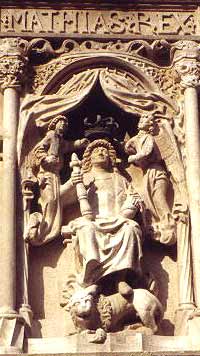
Hungarian Relics in the World: Bautzen
Népszabadság, 2000 III 18, page 29.

The Ortenburg Castle belongs to East German Bautzen's historical central city; one part of the castle was once rebuilt by Mátyás Hunyadi. Since then, the castle tower bears the name of the Hungarian king and is decorated with his image. Expert opinion has it that the bas-relief boldly projecting from the wall, completed in 1486, represents King Mátyás' only authentic likeness. (The head of the composition was transported to Buda several times in those days, and the transfer of the ruler's facial features was perfected there and given its final form.) Copies of the sculpture on Bautzen's square can be viewed for example at the Hilton Hotel in the Buda Castle and above the side entrance of the lower-city church in Szeged.
Bautzen was one of the centers of Lausitz which was settled by the Germans and the Slavic Sorbs. The city lies a thousand kilometers from Buda - in the day when the stately group of statues was completed, Mátyás' kingdom extended this far. The territory, along with Silesia, came to be in the Hungarian ruler's possession as a result of protracted diplomatic and military trials of strength carried on against the Czech and Polish kings. The new situation was blessed at the 1474 peace treaty concluded at Boroszló (Wroclaw), and then after the peace of 1478 by a meeting of the three kings (Mátyás, Ulászló and Kázmár) in 1479 in Olmütz (Olomouc). The spirit of conquest was typical of the age, but according to the chroniclers, the Hungarian king was further spurred to the acquisition of more territory by the desire to become stronger and improve his chances against the Ottoman empire which already held the Balkans firmly in its grip.
Mátyás took his patrimony seriously; he would have liked to accomplish János Hunyadi's dream of driving the Turks from Europe. For this reason, he first wanted to obtain the throne of the Holy Roman Empire. He made notable strides - in 1463 he laid hands on Bosnia, and after the capture of Moravia, he had himself crowned Czech king in 1469; in 1485 he took in Vienna, causing sensitive defeats to the Hapsburgs. However, despite these partial successes, he did not succeed in achieving the final goal. In 1490 King Mátyás died without an heir to the throne, and the anarchy and decline of the decades following his death led directly to the disastrous defeat of Hungary by the Turks at Mohács.
Gy. F.J.
Translated from the Hungarian by Eva M. Thury, copyright 2000. All rights reserved.
Other Hungarian Items on My Site:
The Project I'm Workin On
A King Mátyás Story: the Squash and the Colt.
Fascinating Fasteners.
For the Lovelorn: Hints from Heloise
Hungarian Links